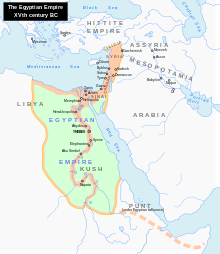 Egyptian empire (highlighted) with Punt in South-East corner (commonly agreed location) | |
| Geographical range | Horn of Africa |
|---|---|
| Dates | c. 2500–980 BCE |
The Land of Punt (Egyptian: ![]() pwnt; alternate Egyptological readings Pwene(t)[1] /puːnt/) was an ancient kingdom known from Ancient Egyptian trade records. It produced and exported gold, aromatic resins, blackwood, ebony, ivory and wild animals.[2] Recent evidence locates it in northwestern Eritrea.[3] It is possible that it includes or corresponds to Opone, as later known by the ancient Greeks,[4][5][6] while some biblical scholars have identified it with the biblical land of Put or Havilah.[7][8]
pwnt; alternate Egyptological readings Pwene(t)[1] /puːnt/) was an ancient kingdom known from Ancient Egyptian trade records. It produced and exported gold, aromatic resins, blackwood, ebony, ivory and wild animals.[2] Recent evidence locates it in northwestern Eritrea.[3] It is possible that it includes or corresponds to Opone, as later known by the ancient Greeks,[4][5][6] while some biblical scholars have identified it with the biblical land of Put or Havilah.[7][8]
At times Punt is referred to as Ta netjer (tꜣ nṯr), lit. 'Land of the God'.[9] The exact location of Punt is debated by historians. Various locations have been offered, southeast of Egypt, a coastal region south of it along the Red Sea, Gulf of Aden and the Indian Ocean, in present day north-east Sudan, Eritrea, northeast Ethiopia, Djibouti and northern Somalia, including Somaliland.
It is also possible that it covered both the Horn of Africa and the area across the sea, in Southern Arabia.[10][11][12] The autonomous state of Puntland, the modern day Somali administrative region at the tip of the Horn of Africa is named in honor of this ancient kingdom.[13]
- ^ Ian Shaw & Paul Nicholson, The Dictionary of Ancient Egypt, British Museum Press, London. 1995, p. 231.
- ^ Shaw & Nicholson, p. 231.
- ^ "We have finally found the land of Punt, where pharaohs got their gifts". New Scientist. 14 December 2022. Retrieved 28 October 2023.
- ^ "Punt". World History Encyclopedia. Retrieved 27 November 2017.
- ^ Flückiger, Friedrich August; Hanbury, Daniel (20 March 2014). Pharmacographia. Cambridge University Press. p. 136. ISBN 9781108069304.
- ^ Wood, Michael (2005). In Search of Myths & Heroes: Exploring Four Epic Legends of the World. University of California Press. p. 155. ISBN 9780520247246.
opone punt.
- ^ Albright, W. F. (1922). "The Location of the Garden of Eden". American Journal of Semitic Languages and Literatures. 39 (1): 20. doi:10.1086/369964. ISSN 1062-0516. JSTOR 528684. S2CID 170465632.
- ^ Sadler, Rodney Jr. (2009). "Put". In Katharine Sakenfeld (ed.). New Interpreter's Dictionary of the Bible. Vol. 4. Nashville: Abingdon Press. pp. 691–92.
- ^ Breasted, John Henry (1906–1907), Ancient Records of Egypt: Historical Documents from the Earliest Times to the Persian Conquest, collected, edited, and translated, with Commentary, p. 433, vol. 1
- ^ Simson R. Najovits (May 2003). Egypt, Trunk of the Tree, Vol. I: A Modern Survey of an Ancient Land. Vol. 1. Algora Publishing. p. 77. ISBN 978-0-87586-234-7.
- ^ Dimitri Meeks – Chapter 4 – "Locating Punt" from the book Mysterious Lands", by David B. O'Connor and Stephen Quirke.
- ^ Where Is Punt? Nova. http://www.pbs.org/wgbh/nova/ancient/egypt-punt.html
- ^ "Puntland profile". BBC News. 11 July 2011. Retrieved 6 March 2023.